Around the Neighborhood - Volume 1, Number 5
In 1973, Family Communications initiated a print newsletter titled Around the Neighborhood. This newspaper-like publication was largely directed towards parents but included some material for children as well. The information below documents the fifth issue.
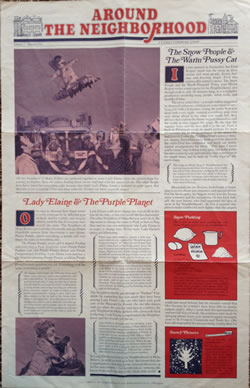
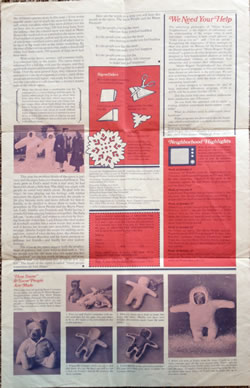
[click images for larger view]
Articles included:
- Lady Elaine & the Purple Planet
- The Snow People & the Warm Pussy Cat
- Snow Pudding
- Snowy Pictures
- Snowflakes
- We Need Your Help
- Neighborhood Highlights
- How Snow & Snow People Are Made
Articles
LADY ELAINE & THE PURPLE PLANET
One way to discover how much better it is for everyone to be different is to sit back, just for a while, and imagine what it could be like if everyone were exactly the same. The Neighbors of Make-Believe get to do that this month, as Lady Elaine Fairchilde returns from discovering a new planet, Planet Purple, where everything is purple and very much the same as everything else.
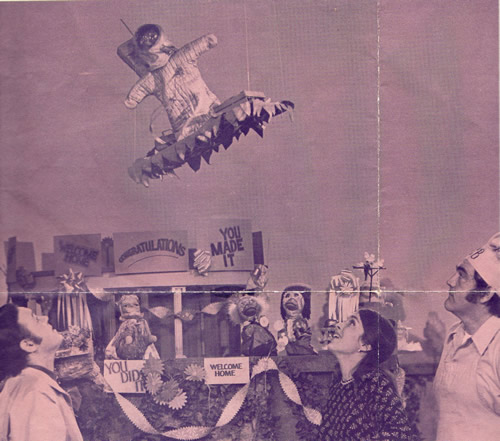
On Planet Purple, every girl is named Pauline and every boy is Paul. Everyone wears Purple Pedal Pushers and eats Purple Peanut Butter and Purple Pumpernickel Pudding. Lady Elaine even receives a gift from her precious Purple Planet: a talking Purple Platter which automatically gives answers in Purple Prose for every question you ask. Everything is all the same; everything is purple!
Of course, real people are different from each other, with different habits and tendencies and likes and dislikes. To keep our differences from getting in each other's way, we bide by a variety of rules that let everyone live more comfortably. Loving people and seeing that they are different from ourselves makes us want to learn a rule called consideration -- trying to give other people a chance to like us and to like being themselves at the same time. As a child grows up he is increasingly able to understand the rules that apply to everyone and to create rules for himself. Respecting himself and loving others are the two most important sources of the rules a child develops for himself.
Lady Elaine is all set to change her way of life to follow all the rules of this new world she has discovered. The other Neighbors of Make-Believe won't do it. No one wants to change his name to Paul, or hers to Pauline; and no one can understand why Lady Elaine is so eager to change hers. Pretty soon, Lady Elaine's antics get infuriating.
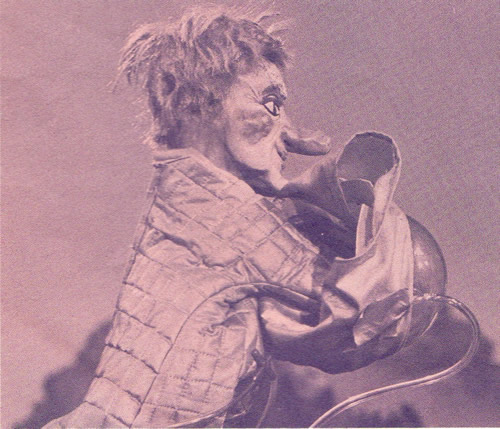
When your child wants to impose a little nonsense order on you -- games like "No talking until I snap my fingers" or "Don't get out of that chair until I come back to the living room," he or she may be practicing important feelings of independence. There are lots of little things a child can be boss of, satisfying the urge to take charge and leaving the bigger, more crucial decisions up to you for now. But when such games interfere with your own adult activities, don't hesitate to say so. Although for a moment your refusal may irritate your child, in the long run his or her development will be aided by the presence of adults who have the strength to manage the behavior of their children as well as their own. Children's bodies are small, and so are their capacities for self-direction. They need to practice discipline in all sorts of ways, by talking and by listening, on you and on themselves.
The Neighbors finally get through the "Pauline" Fairchilde by reminding her how much they have been missing Lady Elaine -- the one who takes such good care of the Museum-Go-Round, the one who dances with joy when she sees her own face in a mirror, the only Neighbor in Make-Believe who dares talk back to the king. Lady Elaine is important to the Neighborhood, and her friends tell her so.
Any stubborn demand calls for attention. Lady Elaine needed the Neighbors of Make-Believe to assure her of her uniqueness among them, so she played at being someone completely different. A child who insists on talking baby talk or crawling for an afternoon may be saying it's time for a little cuddling and soft affection. When an episode of seemingly eccentric behavior takes over your child, watch it happen, and try to read the message underneath it all. Then set the comfortable limits that you all need to grow together.
So Lady Elaine returns to the Neighborhood of Make-Believe, in spirit as well as in fact. She knows that she is appreciated -- not just for her unusual discovery or for her new identity -- but for who she is: someone different from anybody else in the whole wide world.
THE SNOW PEOPLE & THE WARM PUSSYCAT
It was summer in Nantucket, but Fred Rogers' mind was far away in snow storms and snow people, frozen feelings and freezing magic. Fred was writing this winter's opera, The Snow People and the Warm Pussycat. Every year Mister Rogers writes a new opera for his Neighborhood, and though each is only 20 minutes long, it is a complex production involving many people, much work, and months of time.
The story comes first -- a rough outline suggested by themes Fred knows children are concerned about -- being left with a babysitter, losing the teddy bear you sleep with every night, wanting everything your own way, being afraid to try what you might fail. Key phrases that express the theme suggest themselves and the words in turn suggest the songs. By the time the summer fades and the first chill is in the air, Fred is back in Pittsburgh ready to spend perhaps his most pleasurable day in the preparation of the opera. He and Johnny Costa, the Neighborhood's musical director, secrete themselves away from everyone, listen to the tunes Fred has composed, and work out instrumental arrangements for them. "This time I know you're crazy," says Johnny every year, but as he works his own creativity and individuality find expression in the simple tunes, and he ends up "really digging" the opera songs.
The songs on Mister Rogers' Neighborhood are just starting points from which your child might take off in many directions, changing the tune or the words to fit his or her own needs or feelings. Listening to the variations children make of the songs they hear is another way of understanding what they're feeling.
Meanwhile the art director, Jack Guest, is beginning to worry about sets, costumes and special effects. For the Snow opera, his biggest worry was the frozen snow costumes and the snowstorm (it was Jack himself, the year before, who had suggested the idea of snow in the Neighborhood). At first it seemed simplest to make cardboard snow figures that the singers could just stand behind, but the director vetoed that idea because he wouldn't have been able to change camera angles. After a good deal of experimentation and two full days of work, the costumes were made by spraying plastic foam over saran-wrapped sweatsuits sized to fit Francois Clemmons and Yoshi Ito. (We have photographed the process using a teddy bear for the children's picture story in this issue.) Even worse was the snow -- not so much the snow for the opera itself, which was plain white fake snow drifted over the set from slits in canvas bags 200 feet long hung from the ceiling -- but the colored snow was used in Make-Believe the week before as a prelude to the snow opera. Fred insisted on purple, yellow and brown snow, none of which were standard colors and all of which had to be dyed in big wash tubs in the studio workshop. By the time all the various snowstorms, multi-colored and white, had been taped, 200 pounds of fake snow had been used.
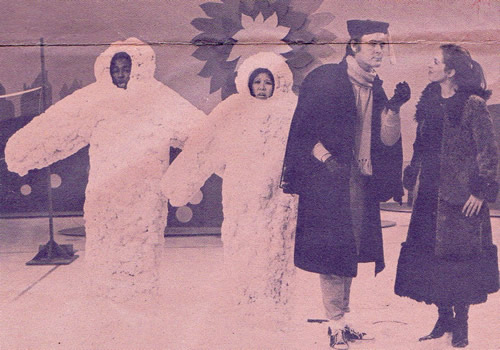
With script, music, scenery, and costumes ready, it is rehearsal time in the studio. The opera music is rehearsed for a full day with just the singers, and then again with singers and musicians all together in a small room. Over the next several days, they rehearse lines and actions (one short segment at a time), until all the pieces are perfected, taped, and ready for the director and the tape editor to edit them into a finished master tape of the whole opera.
Music has always been a comfortable way for many people to express feelings and thoughts. In homes where adults sing as they go about their lives, they often find their infants humming to themselves and their three year olds lilting endless songs, often about hard things like getting hurt or being lost or awful monsters that they might find hard to talk about in words without music. Opera, sophisticated as it appears to most of us, is really this same kind of singing out and playing out of problems that a child uses to deal with difficult times.
This year the problem-theme of the opera is jealousy and the angry behavior that is seeded from it. The story grew in Fred's mind from a real story he had been told about a little boy. The child was angry with people he cared very much about. To deal with his anger, he was playing out his feelings with rubber miniature life figures. As he pretended, the people in his play became more and more difficult for him to handle, so he decided to freeze them to make them powerless. In The Snow People and the Warm Pussycat, Lady Aberlin sees Francois and Yoshi having a wonderful time playing badminton together. She feels left out, "in the cold," and wishes to retaliate by freezing them out of their fun. Lady Elaine (the chief maker of mischief) teaches her a snow recipe that works so well it freezes her friends into immobility. Intent on revenge, Aberlin forgets the recipe for melting snow, and now, scared of what she has done, she obtains the help of Professor Reardon and his warm pussycat to unfreeze her friends -- and finally her own jealous feelings.
The arias in the opera suggest both the predicament of jealousy and some ways to deal with it. "It's the people you like the most who can make you feel the maddest" are the key words in one aria; and in another, "I wish you had been able to tell us how you felt." The finale of the opera is called "Good people sometimes do bad things."
Here are the words to a song you will hear this month in the opera, The Snow People and the Warm Pussycat:
"It's the people you like the most, who can make you feel maddest
It's the people you like the most, who manage to make you feel baddest
It's the people you like the most, who can make you feel happiest
It's the people you like the most, most likely, who manage to make you feel snappiest."
This is how to make snow pudding the way Mister Rogers makes it in the Neighborhood.
Ingredients: 1/4 cup of sugar, 1 package unfiltered gelatin, 1 1/4 cups water, 1/2 cup lemon juice, grated rind from 1 lemon, 2 egg whites
Mix sugar, gelatin and water in saucepan. Cooke just until boiling, stirring constantly. Stir in lemon juice and rind. Let it cool, until mixture mounds when dropped from spoon. Beat egg whites until stiff. Stir gelatin mixture and beaten egg whites together until the pudding holds its shape. Spoon into dishes and chill in refrigerator.
This is an old, soft toothbrush.
If you dip it in white paint and hold it over a piece of dark paper and then pull your finger along the bristles, the paint will spatter onto the paper and look like snow. Try putting down a twig or a leaf and then spattering. See how it looks like a snowy day?
How to cut a paper snowflake (or just a pretty design)
- Fold a piece of paper like this.
- Then cut into the edges any way you like.
- Open it up.
How do you like it?
Every snowflake you make will be different from every other one. And every snowflake that falls from the sky is different from every other one too.
The underlying philosophy of "Mister Rogers' Neighborhood" is the support of self esteem and the understanding of the unique value of each individual, expressed in such simple phrases as "I like you as you are" and "You are special." Recognizing the importance of these messages to their own goals, the Bureau of the Education of the Handicapped has given "Mister Rogers' Neighborhood" a grant to develop programs specifically designed to help handicapped children to understand their similarities and to respect their differences.
"Mister Rogers' Neighborhood" has already produced several programs in this vein which have been shown on television in the past year. We are now reviewing these programs and developing new ones to more directly meet the needs of children concerning handicaps.
A series designed to introduce the idea of basic individual differences, programs #366 to #370, will be re-aired October 15-19.
Did this series help your children understand basic similarities and differences?
Do you think this approach will be useful in helping children understand handicapping conditions?
What do children need to understand about handicaps?
When programs are directed to specific handicaps, which conditions do you think should receive national coverage?
Send your thoughts to: BEH Project Director -- Family Communications Inc, 4802 Fifth Avenue, Pittsburgh, Penn. 15213
Note: If you miss a program you or your child is particularly interested in, check with your local station to see when it will be repeated. Give them the program number.
Week of October 1
Astronaut Al Worden visits the neighborhood on Thursday and Friday (Programs #359 and #360). He talks about how it feels to be left alone in the command capsule. He and Mister Rogers prepare and eat space food.
Week of October 8
Lady Elaine Fairchilde flies to Jupiter (#363). She discovers The Purple Planet where everything is purple and everybody is exactly like everybody else.
Week of October 15
When Lady Elaine returns from Planet Purple on Tuesday (#367), she tells the Neighbors of Make-Believe that on this new planet everyone is the same. Her friends try hard all week to convince her they would all rather be different, and they very much want her to be herself.
Week of October 22
On Friday an opera, The Snow People and the Warm Pussycat (#375) is performed. It stars John Reardon, baritone; Francois Clemmons, tenor; Yoshi Ito, soprano; Betty Aberlin, mezzo soprano. The theme of the opera is how it feels to be left out and jealous.
Week of October 29
Mister Rogers shows children how Picture Picture works on Monday (#376) and how records are made on Wednesday (#378).
HOW SNOW & SNOW PEOPLE ARE MADE
This is the story of making Snow Costumes for an opera you will see in Mister Rogers' Neighborhood called The Snow People and the Warm Pussycat. The people wearing snow costumes in the opera ar real people -- Francois Clemmons and Yoshi Ito -- but we will use a teddy bear in these pictures.
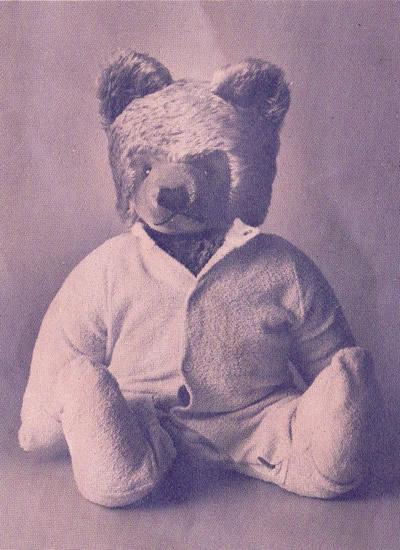
- First we stuff Teddy's pajamas with paper until they are the same size and shape as he is. We make a big fake head on top of the pajamas.
- Then we spray on a kind of foam that looks like snow. Maybe you have seen holiday decorations made from the same thing.
- When the costume dries, we cut it just like toast. We cut the back out and we cut a hole for Teddy's face in the front of the snow costume.
- Teddy just fits in his new snow costume! We glue on a little fake snow to make his costume snowier.
- When you look at Teddy from the front, it looks as if his snow costume goes all the way around him. That's why on television, Francois and Yoshi really look like they're frozen into the snow. To make it look like it's snowing from the sky, we throw fake snow down on Teddy and he looks like he is in a snow storm.
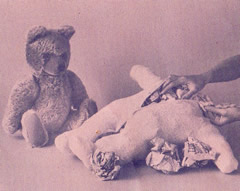
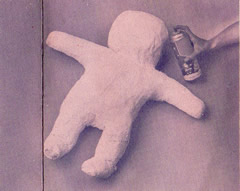
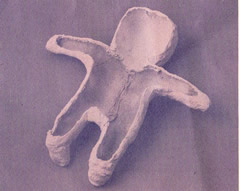
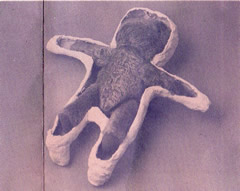
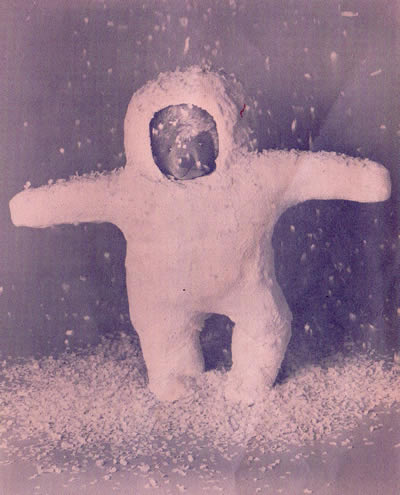
Credits
Around the Neighborhood and the materials that accompany it are published ten times a year by Family Communications Inc., a not-for-profit Pennsylvania corporation.
Around the Neighborhood is created for FCI by Media Projects Incorporated of New York.
Executive Editor: Sara Stein
Editor: Susan Tyler Hitchcock
Editorial Staff: Hedda Sharapan, Mary Gale Moyes
Production Supervisor: Jim Macandell
Graphic Designer: Tobias O'Mara
Editorial Consultants: Petty Wright, Dick Whittingham
© 1973, Family Communications Inc.
